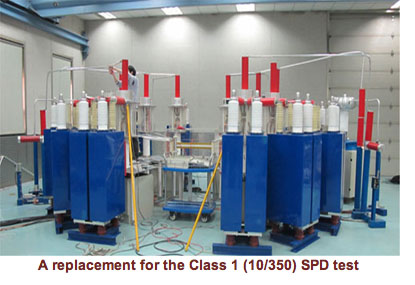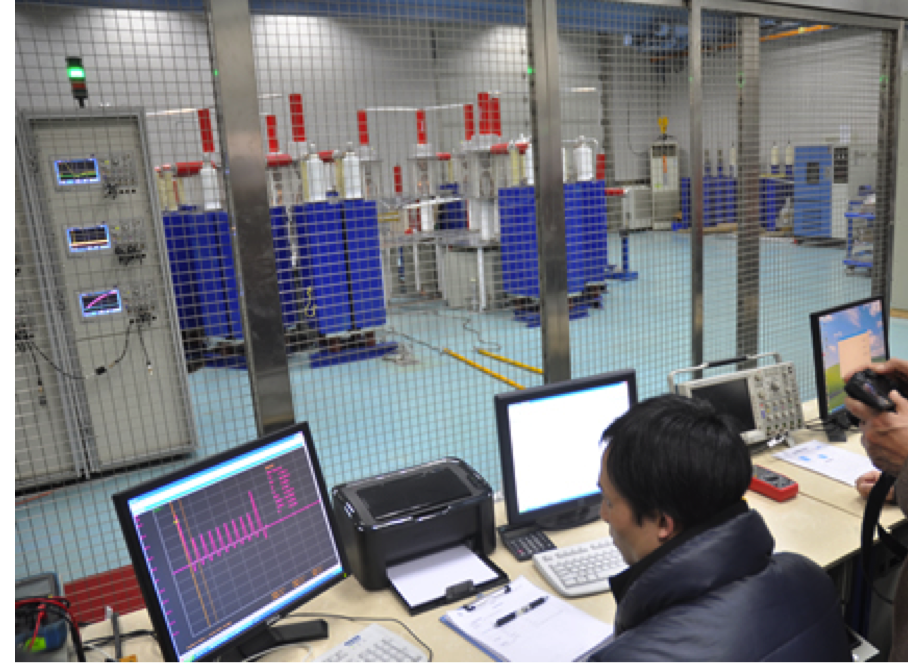TEN350 The waveform that hijacked the IEC lightning standards
SPD test for CIGRE-authenticated lightning parameters

By the time you have reached this page, you will have figured out that the purpose of this website is to improve the workability of lightning protection by ridding international standards of the ill effects of the 10/350 waveform -- this includes mandatory 10/350 testing requirements for SPDs as well as the other practices infected by that waveform.
Achieving progress in an area may require one to stand up and vigorously denounce or eradicate destructive influences such as the 10/350 waveform. But as we all know, it can be all too easy to tear things down. At the same time one should be prepared to proffer an alternative that is at once more workable and can bring lightning protection a little closer to the ideal.
Our proposal is simple. Since the CIGRE 2013 Technical Report 549 has proven that the 10/350 waveform has nothing whatsoever to do with any significant percentage of any type of lightning, it must be eliminated as a mandatory test procedure. In its place, let's test the characteristics of real-world lightning that CIGRE's 2013 report has positively identified. Now that the key features of actual lightning have been documented, it behooves standards writers to use them in creating reality-driven test procedures for SPDs.
CIGRE 2013 FINDINGS PERTAINING TO SPD TESTING PROCEDURES
Over 80% of all cloud-to-ground lightning flashes consist of multiple impulses. Average # strokes: 3-5. Describing 80% of CG lightning , this is arguably the most representative of all lightning characteristics but one that has been totally ignored in the international lightning protection standards. IEC SPD tests all specified single-impulse testing, even though less than 20% of lightning flashes consisted of single impulses. (The notes in the reference section below show that single impulse testing is of extremely limited value since the multiple impulses of actual lightning are far more damaging to SPDs than are single impulses. )
Geometric mean interval between the individual strokes in a lightning flash: 60 ms. IEC lightning protection standards like to give SPDs time to cool down between strokes. That may be great for the spark gap SPDs under test, but not so great for the downstream equipment that's being exposed to the multiple impulses of actual lightning.
Lightning of both polarities can achieve peak currents of 200-300kA. Table 3.2 in the CIGRE report gives peak current distribution as follows: 8% of lightning will exceed 80kA; 5% of lightning will exceed 100kA; 1% of lightning will exceed 200kA.
In over 30% of lightning subsequent strokes have higher Ipeaks than the initial stoke. Subsequent strokes, in some cases, have been shown to cause more damage than initial strokes. This should be accounted for in test procedures.
Lightning waveform: rise time to 90% peak current; time of decay to 1/2 of peak current. With the 10/350 parameters discarded, new waveforms need to be adopted. The CIGRE 2013 report gives the following median first stroke values as its "recommended lightning current waveshape parameters." front time to 90%: 6 µs; tail time to 1/2 value: 77.5 µs; stroke charge: 4.65 Coulombs. In Sect. 7.4 (Current Waveform Parameters) the report references possible parameters for a worst case (1%) positive lightning waveform: Ipeak = 350kA; time to current peak = 11 µs; time to decay to half-peak = 40 µs.
An 8/20 µs waveform might be a sensible waveform to replace the 10/350. Someone may want to make a case for a slightly longer waveform such as 8/50. The relative merits can be debated.
Charge transfer. This is one of those derived parameters that varies as a function of the length of the chosen waveshape. As mentioned above the CIGRE report gives as median first stroke value: 4.65C. The CIGRE 2013 attributes the large charge transfers and specific energy associated with Berger's positive lightning data to "continuing currents."
Specific energy (W/R). This is another one of those derived parameters that varies as a function of the length of the chosen waveshape. See "Charge Transfer" just above. The CIGRE 2013 report additionally points out that specific energy is responsible for the heating effects and mechanical stress when the lightning current flows through mechanical conductors. This can be considered a significant parameter in the design of a linear (constant) resistor, such as the conductors of a lightning protection system. However, when it comes to SPDs -- typically nonlinear devices -- the concept of specific energy based on a constant value of the circuit resistance becomes irrelevant.
Testing apparatus and protocols have already been piloted
At the suggestion of Chinese scientists, Dr. Carson Zang, President of the Shanghai GrandTop Lightning Technology Co., Ltd, (www.grandtop.cn) fabricated testing apparatus that can test and measure all of the above CIGRE 2013 characteristics. Zang's test set-up is capable of replicating lightning flashes consisting of 10 discrete impulses (8/20μs waveform) with the ability to vary both the peak currents (up to 100kA) and the times between impulses (down to 25ms or less.) In December 2011 eleven SPDs were comprehensively tested with this equipment. The procedure and results can be found here.
Further experimentation and trials will doubtless have to be done before a new test setup such as shown to the right shall be fully adopted in standards. In the meantime it will have to be “business as usual” at the various SPD test centers around the world. With the single exception that there should no longer be any mandatory 10/350 wave testing.
Multiple impulse testing references and other data...:
1) Darveniza, M., Andrews, C.J., Mercer, D.R., and Parnell, T.M., "A Multipulse Impulse Generator," presented at Sixth International Symposium on High Voltage Engineering, New Orleans, LA, USA, Aug 28, 1989. This paper, way ahead of its time, predicted the need for simulating actual lightning with multiple impulses.
2) Yaacob, M.M., Aman, A., The Effect of Multiple Lightning Impulse on the Electrical Characteristics of Opto-Isolators. 2nd IEEE International Conference on Power and Energy, Johor Baharu, Malaysia, December 2008. This paper shows that the multiple impulses of actual lightning cause far more severe results than a single impulse and suggests that SPD tests take this into consideration.
3) Yaacob, M.M., Ghani, R.A. "Voltage Current Characteristics of MOVs for low voltage telephone lightning protector under the application of multiple lightning impulse." presented at IEEE International Symposium on Electrical Insulation, Arlington, VA, USA, June 1998. This study shows that multiple impulses cause more damage to an MOV than single impulses. This suggests the need for more robust SPD construction as is also recommended elsewhere in this web.
4) Darveniza,M., Roby, D., Tumma, L.R., Laboratory and Analytical Studies of the Effects of Multipulse Lightning Current on MOVs., IEEE Transactions on Power Delivery, Vol. 9, No. 2, April 1994. This study proves that multiple 8/20 impulses can cause damage to arrestors not evident with standard "single pulse" lightning protection testing. It concludes with recommending multiple impulses to be included in testing standards.
5) Haddad, A., Malek, A., German, D.M., Waters, R.T., "A rotating spark gap for double impulse experiments.", IEEE Xplore, Institution of Electrical Engineers, IEE London, UK, 1996. Reference included because of this documentation concerning spark gap arrestors: "It is well known that following high current sparking, the gap between the electrodes stays "hot" for some time, which affects the recovery time of the spark gap." This is another one of those reasons that spark gaps do so badly at protecting electronic equipment under the conditions of real lightning.